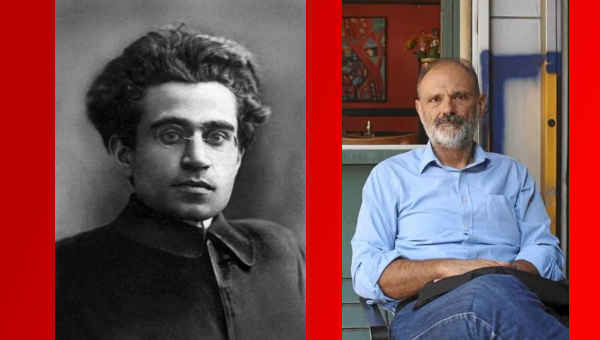Mimmo Porcaro’s project of a “connective mass party” was a response to two opposite experiences: on the one hand to the failure of the traditional communist model of a vanguard party, and on the other hand, to the limits of “horizontal” social movement networks loosely assembled under the umbrella of the World Social Forum. Compared to both, Porcaro’s proposal has significant strengths: For one, the intended connection is no longer conceived of as a quasi automatic consequence of an already connected “multitude” (Hardt/Negri),[1] but rather as a complex political task that needs to confront the manifold social cleavages, for example those between skilled and unskilled parts of the working-class.[2]
 Secondly, the concept of a connective party does not circumvent the question of political leadership but rather re-conceptualizes it under the conditions of today’s high-tech capitalism as cross-sectional leadership. It must be democratized, but it is still necessary in order to overcome the “corporatism” of social movements. The subjects of transformation are multiple and cannot be subsumed under a single class identity, but it is not sufficient to add up the demands of the different movements in a laundry-list. Pluralistic debates and negotiations are important, but they also need to be processed further by the conscious activity of intellectuals that are able to connect them with a concrete analysis of the given hegemonic conjuncture and to transform them into a coherent strategy.
Secondly, the concept of a connective party does not circumvent the question of political leadership but rather re-conceptualizes it under the conditions of today’s high-tech capitalism as cross-sectional leadership. It must be democratized, but it is still necessary in order to overcome the “corporatism” of social movements. The subjects of transformation are multiple and cannot be subsumed under a single class identity, but it is not sufficient to add up the demands of the different movements in a laundry-list. Pluralistic debates and negotiations are important, but they also need to be processed further by the conscious activity of intellectuals that are able to connect them with a concrete analysis of the given hegemonic conjuncture and to transform them into a coherent strategy.
And thirdly, the task is not just to connect the existing social movements, as these are themselves usually maintained by a “popular elite” which is able to muster the time and energy for such civil society activities. In order to overcome the division between highly skilled and unskilled constituencies, the left needs to develop a “social party” (partito sociale) with manifold “mutualistic associations” like cooperatives, popular consumer groups, self-managed nursery schools, etc., which directly benefit the subaltern classes.[3]
Porcaro’s Concept of the Connective Party
Looked at more closely, Porcaro’s concept of the connective party contains both general characteristics and national specifics inherited from the Italian context. When he argues, for example, that leadership positions ought to be held from time to time by different structurally autonomous “movement institutions,”[4] this proposal is in my opinion due to the particular fragmentation of the Italian left and must not be considered to be a general feature of a connective party. Such a rotation principle risks reproducing within the party itself the very corporatism which it proclaims to overcome in the domain of social movements. Efficacious connective politics can also be achieved by a party leadership, which combines the competences of different social movements and areas of expertise, discusses its fundamental strategic decisions in public debates and can be controlled by the base of the party.
I would argue that most of the leftist parties or formations in Europe that are relatively successful right now – e.g. Die Linke in Germany, Izquierda Unida in Spain, the Front de Gauche in France, and above all Syriza in Greece – not only emerged as party coalitions or umbrella organizations, but also contain significant elements of a connective party. The concept of a connective party can be applied to the degree that the existing social and cultural divisions within the subaltern classes and their mediation are made the explicit subject of political analysis and strategy building. The leadership qualities that are for example widely attributed to the new party direction of Die Linke around Katja Kipping and Bernd Riexinger are found in particular connective capabilities on different levels simultaneously: mediating internal party conflicts and overcoming superficial caricatures of competing positions, opening up to various social movements and social milieus in society, working on comprehensive alternative visions to capitalism.[5] The so-called Plan B for a socio-ecological transformation, outlined by the parliamentary group of Die Linke, can be seen as an attempt to counter the prevailing division of social and ecological questions by a strategic combination of ecological transformation, energy-democracy and social justice.[6] The spectacular advancement of Syriza can, at least in part, be explained by specific connective capabilities. For quite a time, there were strong and combative social movements organizing huge demonstrations in Greece against the imposed austerity politics, with no direct impact however, until Syriza succeeded in assembling the impulses of the movements into a connective political alternative, which in June 2012 garnered nearly 27 per cent of the popular vote.
Conversely, the (temporary) defeat of Occupy Wall Street can in part be explained by the fact that there is no connective leftist party in the United States. The problem did not lie where Barbara Epstein located it, namely in the movement’s “insistence upon egalitarianism, its suspicion of the state and aversion to mainstream institutions and culture, and its emphasis on the creation of alternative communities,” which for her is sufficient proof to brand the movement as “anarchistic.”[7] The movement’s “horizontalist” approach clearly contributed to its counter-hegemonic appeal. The movement also forged effective alliances with the labour movement and community groups, and it successfully intervened into the symbolic order and was able to change the power relations in people’s common sense. The problem is rather that so far, it did not muster the political will to initiate a new kind of network-like connective formation that could stabilize these momentary successes. The promising slogan “we are the 99%,” which can be interpreted in Gramscian terms as a bold claim to construct a new and broad “historic bloc” of different subaltern classes, is not yet backed up by a coherent political and organizational strategy, so that the movement continuously risks falling back to the level of single-issue movements and identity politics.[8]
Connective Party of a New Type
That’s why I think the main strategic task is now to develop a connective party of a new type, which is in turn embedded in what Hans-Jürgen Urban called a “mosaic left” of trade unions, social movements, and leftist parties, thus reconstituting the left as a “heterogeneous collective agent.”[9] But how can such a perspective be reconciled with Porcaro’s recent assumption in “Occupy Lenin” (Porcaro 2012) that the “war of position” has been displaced by a “war of movement,” and that we therefore should not be afraid of building tightknit leadership groups, “little sects, germs perhaps of oligarchy or semi-authoritarian regression”?[10] Don’t we have plenty – if not too many – of these already?
It is of course obvious that the economic crisis and austerity politics of neoliberal capitalism has set the social and political landscape of southern Europe in motion, and it is undeniable that we need to draw new strategic conclusions. Porcaro is right when he points out the transition from a relative inclusive capitalism to a “zero-sum capitalism,” whose capacity to engender mass-consensus begins to crack at its very base, and which therefore increasingly relies on the “hard power” of economic blackmail and political force.[11] I also share Porcaro’s critique of a “gradualist” Gramsci-interpretation, which claimed to “first” occupy civil society and “then” the headquarters of capital and of the state, to the effect that the latter task dropped out of sight altogether.[12] One can still sense in the background the traumatic experience of the reformist turn in Italy, which had found its most tangible expression in the transformation of the Partito Comunista Italiano (PCI) into the social-liberal Partito Democratico – a turn that was legitimized among others by a particular reading of Gramsci.
“Contrary to the widespread theories of a necessary collapse of capitalism, Gramsci argued that economic crises cannot by themselves produce fundamental historical events.”
I think however that Porcaro’s diagnosis of a return to a war of maneuver is wrong. For Gramsci, it was exactly Lenin, who by his development of a United Front strategy, has understood the necessity of a transition from a “war of maneuver” to a “war of position,” without however having the time to develop this formula.[13] A frontal attack on the power centers was possible in Russia, where civil society was “primordial and gelatinous,” but not in the hegemonic centers of capitalism, where behind the “outer ditch” of state repression was a “powerful system of fortresses and earthworks.”[14] Another variety of a “war of maneuver” was for Gramsci the economistic and deterministic prejudice that conceives of an economic crisis as opening the breach in the enemy’s defenses, so that one’s own troops can rush in “in a flash” and obtain a definite strategic victory.[15] This also succeeded only before 1917 and later failed because of the very complex structure of civil society.[16] Contrary to the widespread theories of a necessary collapse of capitalism, Gramsci argued that economic crises cannot by themselves produce fundamental historical events, but only “create a terrain more favourable to the dissemination of certain modes of thought.” He even expected the ruling class to be able, due to its “numerous trained cadres,” to adapt to the situation, to make some sacrifices, and to “reabsorb the control that was slipping from its grasp.”[17]
Gramsci’s prudent and sober-minded assessment has so far been corroborated by the experiences with the current economic crisis. Porcaro’s own observations regarding the rupturing of mass consensus can be connected with Gramsci’s remark about an “interregnum,” where the ruling class “has lost consensus,” is no more “leading,” but only “ruling,” whereas the masses are skeptical toward all general formula.[18] Neoliberal capitalism is increasingly incapable of actively mobilizing its subjects and tends to rely predominantly on a “passive consensus,” which can in turn be maintained as long as credible and appealing democratic-socialist alternatives are either not yet worked out or effectively barred from a wider public.[19] In a crisis of hegemony, the potentially more favourite terrain can be used for the construction of an effective counter-hegemony, in a “war of position” that has as such nothing to do with “evolutionism” and a reformist adaptation to bourgeois society. The civil society to be occupied was for Gramsci not “beyond the state,” as Porcaro presumes,[20] but rather a component of his enlarged notion of an “integral state.” Porcaro’s assumption that the left had already “penetrated and sometimes even conquered” the intermediary institutions in the 1970s[21] is an exaggeration, which furthermore disguises the fact that the loss of the “red communes” and other leftist strongholds in civil society meant a devastating defeat, from which the entire left in Italy has not yet recovered. The underlying assessment that civil society is so deeply hollowed out by neoliberal privatization and fragmentation that it is no longer worth investing our energies in its transformation and defense, is based on a rash judgment. For one, civil society was manipulated from above during Fordism as well, on the other hand progressive teachers, journalists, attorneys, trade-unionists, artists etc. still play a crucial role in today’s struggles over hegemony – why would the corporate and political elites otherwise try so hard to keep them away from the hegemonic apparatuses? To argue that it is not the fortresses of civil society that must be taken, but rather the general headquarters of capital and the state that must be seized,[22] is itself an un-dialectical response to reformism. It is already difficult enough to concretely conceive of an immediate conquest of capitalism’s headquarters, which are constantly being displaced and evacuated. It is all the more illusory to imagine that such a conquest could occur without being anchored in and supported by civil society, without a corresponding counter-hegemony and mass mobilization.
Apart from that, Porcaro is absolutely right, when in his interpretation of Lenin he focuses not on the specific contents of his responses, which in most of the cases are outdated, but rather on his pertinent questions, on the “Lenin function” and what one could describe as his political mode of production.[23] What is urgently needed today is something of his capacity of distinguishing the fissures and ruptures in the hegemonic fabric and of grasping the right moment in changing conjunctures. Porcaro is of course also right in pointing out that a connective party also needs to be strategic. It’s not just about communicating different movements and milieus, but also about working on their coherence and political condensation. In the case of Greece, we can only hope that Syriza is well prepared for the immediate steps to be taken after a possible electoral victory. Its interventions will need to be both effective and backed up by mass support in civil society. Much depends on the capacities of developing a strategy that simultaneously disrupts the hegemonic system, changes the power structures, builds sustainable counter-hegemony from below and actually improves the living conditions of the people. •






